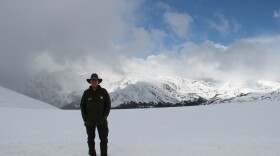Air quality has long been a concern in Colorado; many might remember the skies back in the 1970s and 80s along the Front Range.
"Oh, it was horrible, absolutely," said lifelong Coloradan and state Senator Cheri Jahn (D-Wheat Ridge), "anytime you would go outside of Denver and then come back in, it was the 'brown cloud.'"
"Brown cloud" wasn't hyperbole, it was real, something the Mile High City was infamous for. The new standards announced by the Environmental Protection Agency for ground-level ozone – commonly known as smog – moved the level from 75 parts per billion to 70 ppb. It's a new challenge for many counties that still aren't meeting the old standard.
Near the heart of downtown Denver, at the junction of Champa, Broadway and 21st Street, you'll find a small, one-story brick building with thin metal tubes and pipes poking out of the top, sniffing the air. Stations like this can be found across Colorado and all over the country in high ozone areas, gauging the effectiveness of ozone control measures like cleaner gasoline and scrubbers on power plants.
Major amendments to the Clean Air Act over the past few decades have given the federal government greater authority to regulate air pollutants like ozone. It is done on the basis of air monitoring. Denver has made progress notes, Tyler Svitak of the American Lung Association's Colorado chapter.
"You know, our brown cloud has gotten significantly better," Svitak said, "But our science has gotten better too, and science is telling us the regulations aren't where they need to be yet."
Svitak and the EPA say it's that science leading the Obama administration's push to lower the acceptable ozone threshold for the first time since 2008. But, like with so many arguments over regulation, it comes down to economics.
Svitak said the costs of higher ozone levels are clear: less healthy people, more of the time. While she cares about clean air, state Senator Cheri Jahn thinks the new threshold is too strict.
"You know what it almost feels like," she said of the EPA, "They are setting us up to fail."
Despite serious effort, the highly-populated Front Range is still not meeting the 2008 ozone standards. Federal transportation dollars and other funding can be at risk for areas not in compliance.
List of Colorado counties that already don't meet #ozone standards:
— Stephanie P. Ogburn (@spogburn) October 1, 2015
Adams
Arapahoe
Boulder
Denver
Douglas
Jefferson
Larimer
Weld
"We cannot afford to lose one dollar, because we already don't get enough," Jahn said.
Just outside Jahn's Denver office, construction workers were pouring concrete as part of a road project. Forbes ranks the state's capitol city as one of the fastest growing in the country and traffic can be a total mess. But, road construction in high ozone areas must go through heightened scrutiny to make sure the project does not increase ozone.
Brian Turmail, of industry trade group Associated General Contractors of America, said a stricter ozone standard will just mean more red tape bogging down more road projects in more areas of the country.
"The last thing you want if you're trying to protect the air quality is to force more commuters to spend even more time idling their vehicles while they're stuck in traffic," Turmail said.
Nationally, ozone levels fell more than 30 percent from 1980 to 2014. The EPA predicts the new standards will cost billions, but savings in health benefits will far outweigh that. "Put simply – ozone pollution means it hurts to breathe for those most vulnerable: out kids, our elderly and those suffering from heart and lung ailments," said EPA Administrator Gina McCarthy in the agency's news release. "Our job is to set science-backed standards that protect the health of the American people."
Inside Energy is a public media collaboration, based in Colorado, Wyoming and North Dakota, focusing on the energy industry and its impacts.







